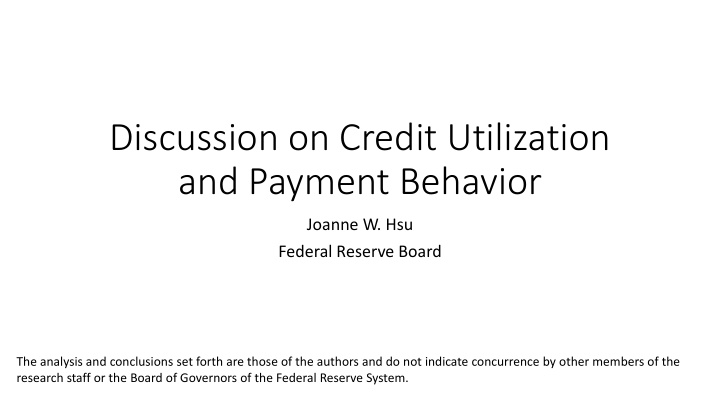



Discussion on Credit Utilization and Payment Behavior Joanne W. Hsu Federal Reserve Board The analysis and conclusions set forth are those of the authors and do not indicate concurrence by other members of the research staff or the Board of Governors of the Federal Reserve System.
Two sides of dealing with credit lines • How does consumption/borrowing respond to exogenous expansion of credit lines? • Having spent on credit cards, how do borrowers allocate payments across accounts? • Borrowing is critical for consumption smoothing, durables, investments, etc., but can be costly • Papers tell us something about how people manage their short-term cash flow: new access credit limits, repayment • Implications for macro policies for stimulating consumption, household financial well-being, and financial stability
Aydın: “The Marginal Propensity to Consume out of Credit” • Randomized experiment involving 54k credit line holders who were already pre-approved by lender for a credit line increase • Control group: no credit limit increases • Treatment group: received credit limit increases in September 2014 • Observation period: 9 months (Sept 2014 – June 2015) • All other terms of the credit line remain constant • Average MPC out of credit: 0.12 after 3 months, 0.17 after 6 months • Response not limited to credit constrained or hand-to-mouth consumers
Aydın • Consumption response primarily on durables/services using installment loan option (as opposed to revolved credit option) • Suggests some may come from “pent-up” demand of infrequently purchased goods/services • Appendix result: no increase in defaults • Suggests that eligible individuals were previously credit constrained, consistent with the fact that they were already pre-approved for higher limits • Table 3: subjects were simultaneously higher income, higher credit score, and yet 40% lower credit limit than all card holders in general • Average credit limit/monthly income ratio: • 3.5 for all cardholders • 2 for experiment participants
Aydın: open questions • Experiment seems to be: what happens when borrowing constraints are relaxed to actually reflect ability to pay/permanent income? • Results show consumption response is not limited those with high utilization. • What are the characteristics of the people who spend versus don't spend? • Would results generalize to markets that don’t have this installment option on the credit card? • In US context, durables purchased via installment loans from the store/dealer • If the experiment started with participants who were unconstrained (or less constrained), then increase their liquidity, what would happen? • Split the sample by bins of credit limit/monthly income ratio?
Mahoney, et al. “ How Do Individuals Repay Their Debt?” • How do credit card borrowers allocate payments across cards? • Data on UK market: can link multiple credit cards held by same individual • Restrict analysis to revolvers using exactly two credit cards • 1.4 million borrowers followed monthly • Interest-minimizing (optimal) strategy: any payment excess of required minimum should be allocated to higher-interest card • Borrowers do not appear to follow this strategy
Mahoney, et al. • Balance-matching heuristic can explain more than half of the predictable variation in repayments • Excess payments allocated proportionally to overall balance on each cards • Other common heuristics (all would imply putting all excess payments on a single card) explain very little • Borrowers are very persistent in their strategies month-to-month
Mahoney, et al.: the role of disclosures? • UK context: What do credit card statements in the UK look like? • What are the implications for making more effective disclosures on credit card statements? • Following the 36-month payoff guideline would yield results close to balance-matching
Mahoney, et al.: open questions • What kind of people have two cards? (as opposed to fewer, and as opposed to more) • Horse-race shows balance-matching best explains 66% of observations: what do these borrowers have in common? • Balance-matching was the only heuristic considered that would yield excess payments on both cards • Repay by lowest capacity, highest capacity, highest balance, lowest balance all fail to explain much • What about heuristics that match on capacity, limits, new purchases? • Can authors quantify the savings that individuals would have if they had made all excess payments on the highest-APR card?
Taking stock • Increased access to credit appears to matter to a broad variety of families, not just those with high utilization or hand-to-mouth • Spending response concentrated in durables, which suggests that consumption induced by increased access to credit may not be long- lasting • Payments strategies, however, eundure: credit card revolvers appear to be leaving money on the table by following sub-optimal payment strategies • Better understanding reasons for this could facilitate improvements in disclosures and other programs focusing on consumer debt behavior
Recommend
More recommend